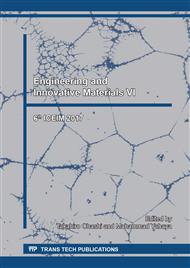p.109
p.114
p.120
p.127
p.132
p.138
p.147
p.155
p.160
Evaluation of Material Deformability and Pressure Distribution on a Die Surface under a Tool in Spot FSF
Abstract:
Friction-stir forming (FSF) is a friction-stir process invented by Nishihara in 2002. In FSF, a material is put on a die, and friction stirring is then conducted on its back surface. The material deforms and precisely fills the cavity of the die due to high pressure and heat caused by friction stirring. Materials in the process often display outstanding deformability and moldability. However, behavior of the material during the friction-stir process has not been sufficiently clarified as a metal forming process. In this paper, material deformability under a tool in spot FSF, i.e. FSF without tool travel, was investigated employing a die having holes. The authors conducted spot FSF on 3mm-thick A5083P-O aluminum plates at offsetting points from the center of a hole and evaluated the height and volume of cylindrical extrusions to evaluate the deformability distribution under a tool. In addition, forming pressure distribution on the die surface was evaluated by an embedded pressure pin connected with a load sensor. The authors conducted spot FSF on 3mm-thick A5083P-O aluminum plates at offsetting points from the center of a pin as well as deformability tests and evaluated forming pressure compiled from the bearing load of the pin. In the deformability test, the extrusions without offsetting were shorter than the ones with 2mm offset. However, the forming pressure without offsetting was higher than the pressure with 2mm offset. Surface sink of the product without offsetting was observed below the tool probe. This implies that the probe restricts supplement of material volume to the die cavity directly below it, though it effectively extends the deformable material volume.
Info:
Periodical:
Pages:
132-137
Citation:
Online since:
January 2018
Price:
Сopyright:
© 2018 Trans Tech Publications Ltd. All Rights Reserved
Share:
Citation:


